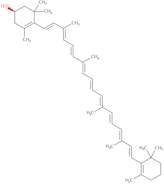
Product Information
- (1S)-3,5,5-trimethyl-4-[(1E,3E,5E,7E,9E,11E,13E,15E,17E)-3,7,12,16-tetramethyl-18-(2,6,6-trimethylcyclohexen-1-yl)octadeca-1,3,5,7,9,11,13,15,17-nonaenyl]cyclohex-3-en-1-ol
- (3R)-Cryptoxanthin
- (3R)-beta,beta-caroten-3-ol
- (3R)-β,β-Caroten-3-ol
- (3R)-β-Cryptoxanthin
- 3-Hydroxy-β-carotene
- Caricaxanthin
- Crp 015
- Cryptoxanthin, all-trans-
- Cryptoxanthine
- See more synonyms
- Cryptoxanthol
- Cryptoxanthol, all-trans-
- E 161c
- Kryptoxanthin
- Neo-β-cryptoxanthin
- Neocryptoxanthin, all-trans-
- Neocryptoxanthol, all-trans-
- Paprika carotene
- Xanthrophyll 1
- all-trans-Cryptoxanthin
- all-trans-β-Cryptoxanthin
- beta-Cryptoxanthin
- trans-Cryptoxanthin
- trans-β-Crytoxanthin
- β,β-Caroten-3-ol, (3R)-
- β-Caroten-3-ol, (R)-all-trans-
- β-Cryptoxanthin
- β-Cryptoxanthin, all-trans-
Beta-cryptoxanthin is a type of carotenoid that is biosynthesized by plants. Beta-cryptoxanthin is found in oranges, tangerines, and other citrus fruits. It has been shown to increase the metabolic rate and body mass index in mice. Beta-cryptoxanthin also has antioxidant properties that are comparable to vitamin C and E. The biological properties of beta-cryptoxanthin have been studied in vitro using k562 cells and 3t3-l1 preadipocytes. These cells were treated with dehydroascorbic acid (DHA), a metabolite of beta-cryptoxanthin, which increased the production of colony stimulating factor 2 (CSF2) and inhibited the activity of p21 protein kinase. This study suggests that beta-cryptoxanthin may be useful for treating inflammatory diseases such as rheumatoid arthritis or cancer.
Chemical properties
Technical inquiry about: 3D-FC158590 beta-Cryptoxanthin - 1%
If you want to request a quotation or place an order, please instead add the desired products to your cart and then request a quotation or order from the cart. It is faster, cheaper, and you will be able to benefit from the available discounts and other advantages.





